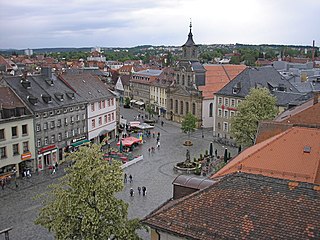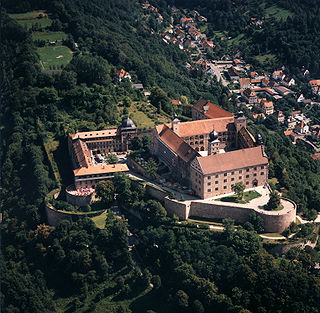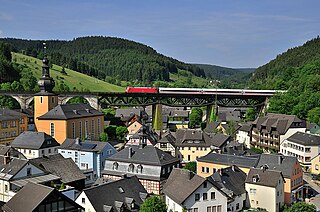Stockenroth | |
|---|---|
| Coordinates: 50°09′40″N11°49′08″E / 50.161°N 11.819°E | |
| Country | Germany |
Stockenroth is a village now belonging to Sparneck in the Hof district, Bavaria, Germany.
Stockenroth | |
|---|---|
| Coordinates: 50°09′40″N11°49′08″E / 50.161°N 11.819°E | |
| Country | Germany |
Stockenroth is a village now belonging to Sparneck in the Hof district, Bavaria, Germany.
The village is situated on the river Saale between the Fichtel Mountains and Franconian Forest. The highest point is the Schachtel- or Schlegelsberg (591 m) in the southwest, lowest point is the Saale (512 m). The village has, together with the twin-village Germersreuth 110 inhabitants. The only four original homestead farms where situated in a loose manner around the small creek Foehrenbach, which flows into the Saxonian Saale after only a short way. All four original houses face the center of the village, an unusual set up, as normally the houses at that time faced south.
Stockenroth-Germersreuth, as the village officially is named, was founded in the beginning of the 12th century by the Walpots. Shortly after foundation the power was transferred to the Knights of Sparneck. These put their lands in 1356 under the Bohemian crown, a state that only changed when the Principality of Bayreuth became an integral part of Prussia in 1792.
Castle Stockenroth was the seat of the administration for the surrounding villages from 1563 until 1731. During that era the village and its castle were heavily used for hunting purposes by the margraves of the Principality of Bayreuth. During that reign of the Hohenzollern, which lasted in Stockenroth till 1806, the castle was also a centre of horse breeding, related of the famous Trakehner horses in then Prussian Lithuania. It was also relevant in introducing the potato as a staple food in Prussia through its connections to Bohemia, which was then reigned by the Habsburg dynasty and therefore had indirect access to the Spanish colonies.
The sports club ASV Stockenroth has 220 members. Main sports is football (soccer), cross-country skiing, and athletics. The auxiliary fire brigade Stockenroth was founded 1875. As the then ruling Hohenzollern became Protestants in the 16th century, the inhabitants are mainly of Lutheran believe.

George Frederick of Brandenburg-Ansbach was Margrave of Ansbach and Bayreuth, as well as Regent of Prussia. He was the son of George, Margrave of Brandenburg-Ansbach and a member of the House of Hohenzollern. He married firstly, in 1559, Elisabeth of Brandenburg-Küstrin. He married secondly, in 1579, Sophie of Brunswick-Lüneburg, daughter of William of Brunswick-Lüneburg and Dorothea of Denmark.

The House of Hohenzollern is a formerly royal German dynasty whose members were variously princes, electors, kings and emperors of Hohenzollern, Brandenburg, Prussia, the German Empire, and Romania. The family came from the area around the town of Hechingen in Swabia during the late 11th century and took their name from Hohenzollern Castle. The first ancestors of the Hohenzollerns were mentioned in 1061.

Hohenzollern-Sigmaringen was a principality in Southwestern Germany. Its rulers belonged to the senior Swabian branch of the House of Hohenzollern. The Swabian Hohenzollerns were elevated to princes in 1623. The small sovereign state with the capital city of Sigmaringen was annexed to the Kingdom of Prussia in 1850 following the abdication of its sovereign in the wake of the revolutions of 1848, then became part of the newly created Province of Hohenzollern.

Bayreuth is a town in northern Bavaria, Germany, on the Red Main river in a valley between the Franconian Jura and the Fichtelgebirge Mountains. The town's roots date back to 1194. In the 21st century, it is the capital of Upper Franconia and has a population of 72,148 (2015). It hosts the annual Bayreuth Festival, at which performances of operas by the 19th-century German composer Richard Wagner are presented.

The Kingdom of Prussia was a German kingdom that constituted the state of Prussia between 1701 and 1918. It was the driving force behind the unification of Germany in 1866 and was the leading state of the German Empire until its dissolution in 1918. Although it took its name from the region called Prussia, it was based in the Margraviate of Brandenburg. Its capital was Berlin. Due to the fact that Brandenburg was the seat of power and prominent part of the entity, the state is also referred to as Prussia-Brandenburg or Brandenburg-Prussia and sometimes erroneously as the Kingdom of Brandenburg or the Kingdom of Nordmark.

Hof is a town on the banks of the Saale in the northeastern corner of the German state of Bavaria, in the Franconian region, at the Czech border and the forested Fichtel Mountains and Franconian Forest upland regions. The town has 47,296 inhabitants, the surrounding district an additional 95,000.

Kulmbach is the capital of the district of Kulmbach in Bavaria in Germany. The town, once a stronghold of the Principality of Bayreuth, is renowned for its massive Plassenburg Castle, which houses the largest tin soldier museum in the world, and for its sausages, or Bratwürste.

The Principality or Margraviate of (Brandenburg-) Ansbach was a free imperial principality in the Holy Roman Empire centered on the Franconian city of Ansbach. The ruling Hohenzollern princes of the land were known as margraves, as their ancestors were margraves.

The Principality of Bayreuth or Margraviate of Brandenburg-Bayreuth was an immediate territory of the Holy Roman Empire, ruled by a Franconian branch of the Hohenzollern dynasty. Since Burgrave Frederick VI of Nuremberg was enfeoffed with the Margraviate of Brandenburg in 1415/17, the Hohenzollern princes transferred the margravial title to their Franconian possessions, though the principality never had been a march. Until 1604 they used Plassenburg Castle in Kulmbach as their residence, hence their territory was officially called the Principality of Kulmbach or Margraviate of Brandenburg-Kulmbach until the Empire's dissolution in 1806.

Plassenburg is a castle in the city of Kulmbach in Bavaria. It is one of the most impressive castles in Germany and a symbol of the city. It was first mentioned in 1135. The Plassenberg family were ministerial of the counts of Andechs and used as their seat the Plassenburg. The House of Guttenberg, a prominent Franconian noble family, traces its origins back to 1149 with a Gundeloh v. Blassenberg (Plassenberg). The name Guttenberg is derived from Guttenberg and was adopted by a Heinrich von Blassenberg around 1310. From 1340, the Hohenzollerns governed from Plassenburg castle their territories in Franconia till 1604. The Plassenburg was fortress and residence for the Hohenzollerns.
The Principality of Halberstadt was a state of the Holy Roman Empire ruled by Brandenburg-Prussia. It replaced the Bishopric of Halberstadt after its secularization in 1648. Its capital was Halberstadt. In 1807, the principality was made a state or regional capital of the Kingdom of Westphalia. In 1813, control of the principality was restored, and its sovereign rights were confirmed as the possession of the Kingdom of Prussia.

The history of Saxony began with a small tribe living on the North Sea between the Elbe and Eider River in what is now Holstein. The name of this tribe, the Saxons, was first mentioned by the Greek author Ptolemy. The name Saxons is derived from the Seax, a knife used by the tribe as a weapon.

Jungingen is a municipality in the Zollernalbkreis, Baden-Württemberg, Germany. It is located nearby the castle Burg Hohenzollern, about 5 km east of Hechingen.

Ludwigsstadt is a town in the district of Kronach, in the Upper Franconian region of Bavaria, Germany.
The state of Prussia developed from the State of the Teutonic Order. The original flag of the Teutonic Knights had been a black cross on a white flag. Emperor Frederick II in 1229 granted them the right to use the black Eagle of the Holy Roman Empire. This "Prussian Eagle" remained the coats of arms of the successive Prussian states until 1947.

The Margraviate of Brandenburg was a major principality of the Holy Roman Empire from 1157 to 1806 that played a pivotal role in the history of Germany and Central Europe.

Christian Friedrich Carl Alexander was the last margrave of the two Franconian principalities, Bayreuth and Ansbach, which he sold to the King of Prussia, a fellow member of the House of Hohenzollern.
Christian Heinrich of Brandenburg-Bayreuth-Kulmbach, was a German prince and member of the House of Hohenzollern and nominal Margrave of Brandenburg-Bayreuth-Kulmbach.

Frederick (Friedrich) Margrave of Brandenburg-Bayreuth, was a member of the House of Hohenzollern and Margrave of Brandenburg-Bayreuth.

The Principality of Brunswick-Wolfenbüttel was a subdivision of the Duchy of Brunswick-Lüneburg, whose history was characterised by numerous divisions and reunifications. It had an area of 3,828 square kilometres in the mid 17th century. Various dynastic lines of the House of Welf ruled Brunswick-Wolfenbüttel until the dissolution of the Holy Roman Empire in 1806. As a result of the Congress of Vienna, its successor state, the Duchy of Brunswick, was created in 1815.